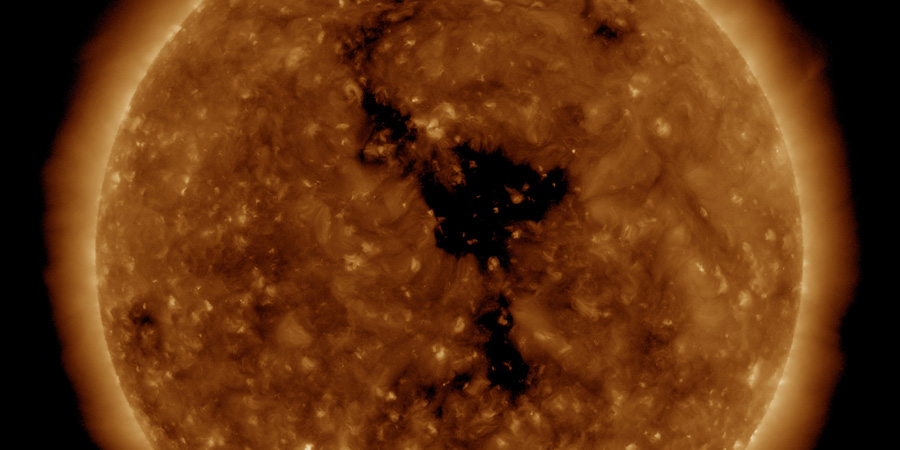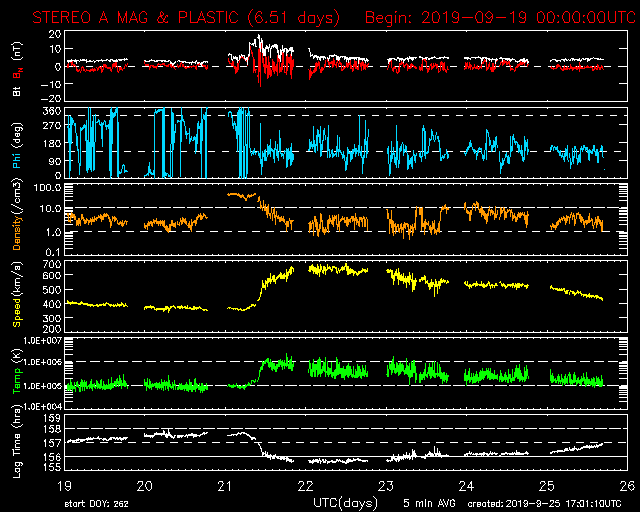Coronal hole faces Earth, G1 watch
Wednesday, 25 September 2019 17:16 UTC

A familiar coronal hole is facing our planet today. You might remember this transequatorial coronal hole because it faced our planet at the end of August and caused moderate G2 geomagnetic storm conditions on 31 August and minor G1 geomagnetic storm conditions on 1 and 2 September.
A transequatorial coronal hole is facing Earth. Enhanced solar wind could arrive in ~3 days - Follow live on https://t.co/bsXLidnzGh pic.twitter.com/NyCfpmQUYk
— SpaceWeatherLive (@_SpaceWeather_) September 25, 2019
We do see that the coronal hole changed in shape quite dramatically during its trip around the far side of the Sun. It still covers an impressive area but it lost its T-shape. It does however now connect all the way up to the northern hemisphere polar coronal hole. Does that mean we should again expect moderate storm conditions? Perhaps... lets look at the data from STEREO Ahead to see what we should expect:

The NOAA SWPC has already issued a minor G1 geomagnetic storm watch in place for this Friday, 27 September which is very reasonable. We do expect this coronal hole solar wind stream to arrive during the second half of 27 September. STEREO Ahead shows a very decent magnetic field strength (Bt) at the onset of the solar wind stream near 20nT with a maximum southward deflection just below -10nT and solar wind speeds up to 700km/s during the peak of the high speed stream. This is not a guarantee that we see similar numbers at Earth but it gives us a great indication what to expect.
Based on the data presented to us by STEREO Ahead we conclude that minor G1 geomagnetic storm conditions are likely on 27 and 28 September, possibly on 29 September as well. Moderate G2 geomagnetic storm conditions cant be excluded for a short period on the 27th or 28th but don't be too surprised if we top out at minor G1 geomagnetic storm conditions. Keep your eyes on the sky this weekend and of course on your phone to see all the SpaceWeatherLive geomagnetic storm alerts pop up on your phone... providing you have our app installed of course! Haven't done that yet? What are you waiting for? Head over to your Android or Apple app store and download it now. Good luck!
Apple, the Apple logo, iPhone, and iPad are trademarks of Apple Inc., registered in the U.S. and other countries and regions. App Store is a service mark of Apple Inc.
Thank you for reading this article! Did you have any trouble with the technical terms used in this article? Our help section is the place to be where you can find in-depth articles, a FAQ and a list with common abbreviations. Still puzzled? Just post on our forum where we will help you the best we can!
Latest news
Latest forum messages
Support SpaceWeatherLive.com!
A lot of people come to SpaceWeatherLive to follow the Sun's activity or if there is aurora to be seen, but with more traffic comes higher server costs. Consider a donation if you enjoy SpaceWeatherLive so we can keep the website online!

Space weather facts
| Last X-flare | 2025/03/28 | X1.1 |
| Last M-flare | 2025/04/01 | M2.5 |
| Last geomagnetic storm | 2025/03/27 | Kp5 (G1) |
| Spotless days | |
|---|---|
| Last spotless day | 2022/06/08 |
| Monthly mean Sunspot Number | |
|---|---|
| February 2025 | 154.6 +17.6 |
| April 2025 | 152.5 -2.1 |
| Last 30 days | 130.7 -17.9 |




